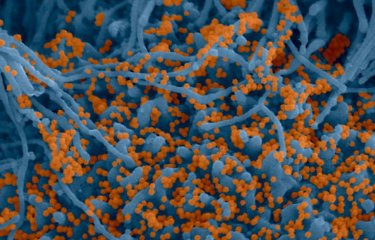-
Article | 2020.06.16
Development of a test to identify inhibitors of SARS-CoV-2 proteases
Aim: SARS-CoV-2 proteases are essential to the life cycle of the virus and are highly conserved in the beta-coronavirus family. This is how the Cov2-Pls-project researchers will develop a high-throughput screening system to identify inhibitors that can effectively block the action of SARS-CoV-2 proteases, and thus stop the proliferation of the virus. The molecules identified could help...
-
Article | 2020.06.16
Find potent antiviral drugs against SARS-CoV2 by targeting well identified proteins essential to the viral cycle
Aim: The DrugDesign_SARS2 project aims to find effective antiviral drugs against SARS-CoV-2 that target proteins essential to the viral cycle. The project brings together the expertise of several laboratories and platforms of the Institut Pasteur International Network (Paris, Lille, Rome). The aim of the study is to examine a large number of compounds as quickly as possible using...
-
Article | 2020.06.16
Descriptive study: epidemiological, clinical and immunological analysis of SARS-CoV-2 cases in the Metropolitan Region of São Paulo, Brazil
Aim: to identify and analyze the profile of people infected with the SARS-CoV-2 virus in São Paulo, Brazil. This project will be conducted in the Metropolitan Region of São Paulo, one of the most densely populated areas in the world, where the contact rate is accordingly high. By studying epidemiological, clinical and serological aspects of infected individuals, this work will supplement...
-
Article | 2020.06.16
Serological surveillance of SARS-CoV-2 and seasonal coronaviruses
Aim: Serology is an important complementary tool to real-time PCR for diagnosing SARS-CoV-2, allowing detection of past and current infections. A multiplex Luminex serological assay will be optimized in Paris and transferred to Dakar, Abidjan and Yaoundé where blood samples will be tested for antibodies to SARS-CoV-2 and seasonal coronaviruses. Mathematical models will classify infected...
-
Article | 2020.06.16
The use of Artificial Intelligence Methods to Discriminate Covid-19 from other Community Acquired Pneumopathy using Chest X-Ray and CT images
Aim: Diagnostic of SARS-CoV-2 Coronavirus caused-disease (Covid-19) is a bottleneck in the immediate follow-up of patients. We propose automated detection methods based on Artificial Intelligence (AI) Algorithms (Machine Learning and Form Recognition), on chest Computed tomography (CT) or X-Ray images, to discriminate the Covid-19 disease from other Community Acquired Pneumonia (CAP). The methods...
-
Article | 2020.06.16
Household transmission investigation study for SARS in overseas territories
Aim: EPI-COVID-19, a research project in epidemiology to study intra-household transmission around cases of Covid-19 confirmed in French Guiana.The EPI-COVID study, covering 250 households (150 in French Guiana, 50 in Guadeloupe and 50 in New Caledonia), should make it possible to investigate the secondary infection rate, the speed of spread of the virus, the proportion of asymptomatic cases...
-
Article | 2020.06.16
Covid-19 risk evaluation among the household contacts of the first cases in Africa
Aim: Once the first Covid-19 cases will be identified, the spread of the SARS-CoV-2 will be related with the level of the transmission risk. This study aims to obtain an early understanding of key epidemiological characteristics in the family contacts in different African countries of the IPIN to inform decision makers about the potential spread and impact of SARS-CoV-2 infection in the closest...
-
News | 2020.06.16
Novel neurotropic arbovirus identified in France: the Umbre virus
The Institut Pasteur's Pathogen Discovery Laboratory and the neuropathology laboratory at Pitié-Salpêtrière Hospital set out to identify pathogens in fatal cases of encephalitis of unknown etiology. In two immunosuppressed patients, the Umbre virus (genus Orthobunyavirus) was identified. This virus infects neurons in the cerebral cortex, the spinal cord and the liver. The discovery of a novel...
-
Document de presse | 2020.05.29
A preclinical study shows that hydroxychloroquine has no antiviral effect on SARS-CoV-2 in vivo
A study on the effects of hydroxychloroquine n macaques infected with the SARS-CoV-2 virus, used alone or in combination with azithromycin, have been pre-published(1) on Research Square, after their submission to Nature. Scientists from the CEA, Inserm, Institut Pasteur, Université de Paris-Saclay, Université Claude Bernard Lyon 1 and Aix-Marseille Université have been involved in the study...
-
Page avancée | 2020.06.17
All SARS-CoV-2 / COVID-19 from the Institut Pasteur
All SARS-CoV-2 / COVID-19 from the Institut Pasteur


